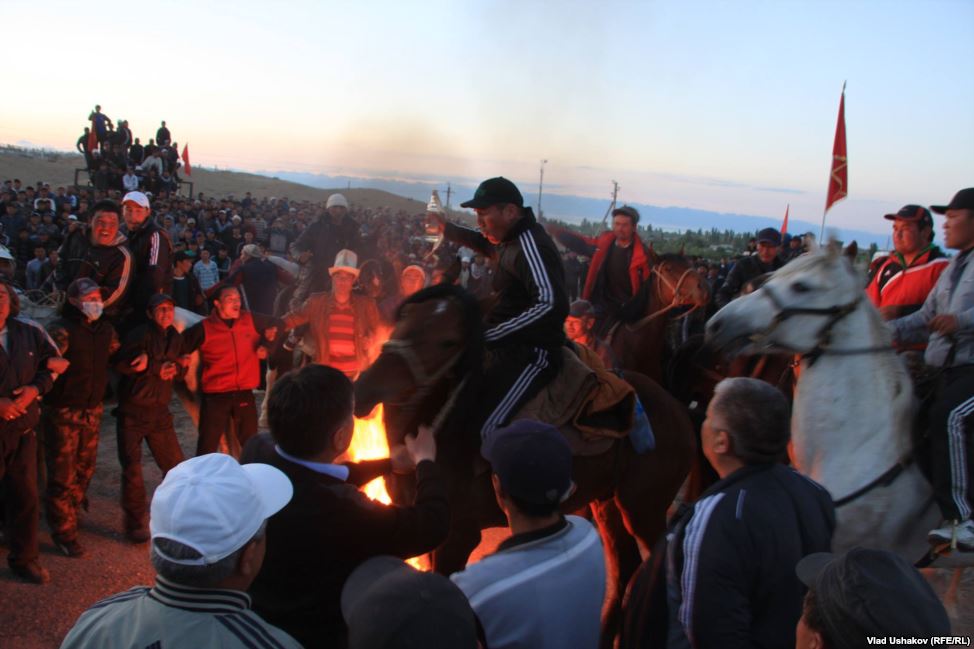
Kumtor Gold Mine Protests and Unrest Rock Kyrgyzstan
Publication: Eurasia Daily Monitor Volume: 10 Issue: 107
By:

The notorious spring season in Kyrgyzstan was again marked by intensified protest activity this year. On May 31, protesters demanding the nationalization of the locally-based Kumtor gold mine clashed with security forces in a northern district of Jeti-Oguz of the Issyk-Kul province in what was this year’s most violent confrontation. The clashes left dozens of people wounded, including police, prompting authorities to declare a state of emergency and impose a curfew in the area until June 10. The incident has also sparked renewed speculations of “third forces” seeking to undermine the government and fears of potential destabilization in the country rocked by two government overthrows and inter-ethnic clashes in the last eight years.
The protest started on May 28 with protesters blocking the road that leads to the mine and preventing the transit of foodstuffs and fuel necessary for its operation. Two days later, demonstrators took over a power station and cut off electricity to the mine for several hours, triggering intervention by police who arrested dozens of demonstrators. The following day, hundreds of protesters gathered to demand the release of the detained activists, sparking clashes with security forces, which used stun grenades and tear gas to disperse the crowd after it attempted to storm the local Kumtor mine office. Protests in the area have seemingly ended for now, and the mine is currently operating as normal (www.24kg.org, May 31, June 3).
The incident in the northern province of Issyk-Kul was followed by unrest in the southern city of Jalal-Abad where hundreds of protesters stormed the provincial administration building to voice similar demands and install their own governor, Meder Usenov, from within the Ata-Jurt opposition party. Authorities detained the individual, triggering protest actions in Jala-Abad demanding his release. The demonstrators attempted to storm the provincial state administration and the provincial administration of the State Committee of National Security. Protesters also blocked the strategic highway that links Bishkek in the north and Osh and Jalal-Abad in the south. Authorities stated on June 3 that they do not intend to use force and will rely on negotiations to remove the blockade (www.24kg.org, May 31, June 3).
The Ata-Jurt party, which primarily enjoys support in the south, lost the 2011 parliamentary elections held months after the country switched from a presidential to a parliamentary system of governance in 2010. The switch was made possible as a result of the new constitution adopted in the aftermath of the popular revolt that unseated former President Kurmanbek Bakiev in April 2010 and the clashes between ethnic Uzbeks and Kyrgyz in the south later that summer. Over the past two years, the party has led major protest actions against the mine as part of its campaign to discredit the government and the parliamentary system of governance. Last October, it organized a protest in Bishkek demanding nationalization of the mine, which led to the arrest of the party leader and two other members for their alleged call to overthrow the government. In March 2013, all three were given light sentences in what appears to be an attempt by the government to placate the opposition party and its supporters. In addition to their demand to nationalize Kumtor, protesters in Jalal-Abad on May 31 were also demanding the release of the party members, threatening to install local mayors and district administrators in the province and create a coordination council to give power to the people (www.vb.kg, May 31).
Protesters in Jalal-Abad and Issyk-Kul provinces also demanded the denunciation of the government’s agreement with the Canadian-based company Centerra, which operates the mine. They claim that the deal was concluded unfairly in 2009 and that the mine underpays in taxes and social welfare while damaging the environment. The government, which owns a third of the mine shares, in February 2013 fined the company $315 million for environmental damages and demanded a renegotiation of the contract, allegedly giving the company until June 1, 2013 to do so, or else face repudiation. On the day of the May 31 protests, Prime Minister Jantoro Satybaldiyev stated that more time was needed for talks on the mine. “They agree to establish a joint venture by unbundling Kumtor from Centerra and registering it in Kyrgyzstan. If such a joint venture is created, cash flow will double,” he added (www.inozpress.kg, June 1). In 2011, the mine contributed to 12 percent of the country’s GDP and almost half of its industrial output.
Speculations abound in the media that the May 31 protests in both provinces were a coordinated action of “third forces,” with a lot of blame being leveled at the former President Bakiev and his supporters who allegedly seek to undermine the government led by Prime Minister Satybaldiyev and President Almazbek Atambaev. Bakiev’s adherents have been reportedly filling the ranks of the Ata-Jurt party ever since he was removed from power in popular protests. Bakiev hails from the Jalal-Abad province—a major support base of the opposition party—and was one of the opposition leaders who took the reins of the presidency after his predecessor from the north, Askar Akaev, was toppled in popular protests over socio-economic issues in 2005. The two former heads of state have since been in exile in Belarus and Russia, respectively (www.24kg.org, May 31; www.hurriyetdailynews.com, May 31).
Major socio-economic issues that remain unaddressed put the current administration in a precarious position, especially because the Kumtor mine has emerged as the focal point of continued anti-government protests in both southern and northern regions of Kyrgyzstan. These demonstrations and the May 31 incidents, in particular, will impact negatively on the country’s tourism sector and on the investment climate at a time when the government needs overseas investments to meet the targets of its recently unveiled economic development strategy. When protests demanding the nationalization of the mine led to the suspension of mine operations in 2012, the country’s economic growth declined by somewhere between 1 and 3 percent, according to varying sources (www.kabar.kg, May 31; www.24kg.org, May 31).
The protests over the Kumtor mine have exposed the government’s challenge in promoting investment opportunities on the one hand and in protecting perceived national interests on the other. And while Kyrgyzstan’s government has shown an ability to protect the foreign investor this time, the uncertainty regarding the mine’s status will continue fueling tensions between authorities and opposition groups that seek to discredit the government and the parliamentary system of governance. Distrust toward local and central authorities in Kumtor-related protests will, meanwhile, continue weakening the government’s legitimacy and its attempts to ensure law and order. A quicker resolution of the Kumtor issue may cool down these tensions, but new issues will surely emerge that will be exploited by oppositions groups vying for power.




